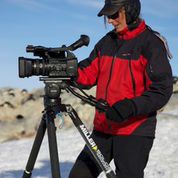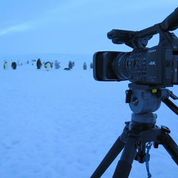Miller Camera Support Equipment Goes to the Edges of the Earth with Dr. Frederique Olivier to Document Animals of the World
ANTARCTICA — For the past 15 years, freelance camera operator Dr. Frederique Olivier has made a career of traveling to remote and harsh environments on Earth to document some of the most isolated animals on Earth. For Olivier, equipment selection is critical, as there are often no readily available repair shops in the secluded locations to which she travels. That’s why Olivier has come to rely on Miller Camera Support Equipment, a leader in the production of innovating camera support solutions, for her tripod needs.

Olivier has thus far enjoyed a 10-year relationship with Miller, and whether it’s documenting Adelie penguins in Antarctica, Common Bottlenose dolphins in Shark Bay, Western Australia, or various other animals in the distant corners of the world, she knows that she can count on her Miller camera support equipment to work every time, in any climate. “Miller’s equipment is sturdy, simple and reliable for deep field work, in which your tripod has to be your best mate,” says Olivier. “I especially appreciate the lightweight and versatility of the Solo legs, and I would not trade them for anything else.”

On one of her most recent expeditions, Olivier was in Antarctica shooting the plight of the Adélie penguin for the documentary, “Penguins: Spy in the Huddle,” by John Downer Productions. She needed to cover an incredible distance, as the penguins migrated back and forth from their colony onto the ice and to the sea to feed, and the work involved its set of challenges. Aside from frigid daily temperatures, with wind chills dipping to negative 20 degrees Celsius, Oliver also endured quite a bit of climbing on uneven terrain, elevation changes and re-setting location multiple times throughout the day for eight weeks on-end.

“Without a field assistant, a light but sturdy camera kit was a must,” says Olivier. “While I chose to work with the latest Sony compact 4k camera for its light weight, my tripod had to be heavy enough to withstand the 30 to 40 knot katabolic winds of blustery Antarctica with limited vibrations. To combat these challenges, my Miller Compass 25 Fluid Head was my best friend on this shoot. The weight of the 100mm head helped me to deliver a smooth pan despite being buffeted by raging blizzard winds. Additionally, I was able to well-handle the large pan and tilt dials with thick gloves on my hands.”
Olivier chose to set the Compass 25 Fluid Head on carbon fibre Solo legs for this shoot, which she says allowed her to easily carry the whole kit on one shoulder, as well as to shoot comfortably in awkward situations with its long leg range. “Since the Adélie penguins are rather short, maintaining the eye line with the subject was always a challenge, but one easily overcome with the flat maximum opening leg spread,” she says. “But it was the ease and speed of setup of the system that proved to be the key to the shoot’s success, as I was working as a single operator. The swifter that one can be when working near penguins, the less the birds are disturbed, and the more likely they are to resume business as usual and forget about the cameraman!”
And if it’s not penguins Oliver is working hard to shoot in their natural habitat, its other distinctive mammals—Common Bottlenose dolphins, for instance. Last winter, Olivier received the opportunity to profile the blitz behavior of Common Bottlenose dolphins in Shark Bay, Western Australia for another documentary, “Dolphins: Spy in the Pod,” by John Downer Productions. The dolphins have an interesting feeding pattern in which they corner fish in the wave zone before suddenly hydroplaning right onto the beach to capture the frightened fish. In total, the behavior lasts for barely ten seconds, which means that it was imperative for Oliver to be right on the scene, running alongside the dolphins as they swam along shore, armed and ready to capture the feeding frenzy the second it happened.
“I ended up positioning a Red One Camera on the Miller Arrow 30, a rig of more than 15 kilograms, as a fixed system on top of one of the higher sand dunes,” she says. “To follow the dolphins, I resorted to my best roaming option, the Miller DS10 Tripod System with the carbon fibre Solo legs paired with a Canon XF305. With less than 8 kilograms on my shoulder, I could actually sprint on the soft sand to keep up with the speed of a swimming dolphin!”
The professional video industry's #1 source for news, trends and product and tech information. Sign up below.
Currently, Olivier is once again back in Antarctica, where she continues to rely on her Miller camera support equipment as she documents her next great adventure, capturing shots of some of the world’s most beautiful and exotic animals. This latest documentary is set to release in 2016.
“I continue to have a wonderful relationship with Miller,” concludes Olivier. “The company has a great customer support service center, and they are always readily available. All of the gear has seen a lot of miles but keeps going strong. I would consider my Miller camera support equipment to be the best support tools I own to use when working out in the field in extreme weather climates.”
